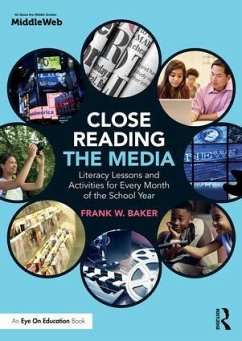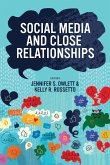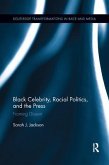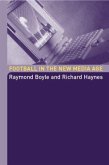Frank Baker
Close Reading the Media
Literacy Lessons and Activities for Every Month of the School Year
Frank Baker
Close Reading the Media
Literacy Lessons and Activities for Every Month of the School Year
- Broschiertes Buch
- Merkliste
- Auf die Merkliste
- Bewerten Bewerten
- Teilen
- Produkt teilen
- Produkterinnerung
- Produkterinnerung
In this timely book copublished by Routledge and MiddleWeb, media literacy expert Frank W. Baker offers thematic lessons for every month of the school year, so you can engage students in learning by having them analyze the real world around them.
Andere Kunden interessierten sich auch für
![Social Media and Close Relationships Social Media and Close Relationships]() Social Media and Close Relationships60,99 €
Social Media and Close Relationships60,99 €![The Dark Side of Close Relationships II The Dark Side of Close Relationships II]() The Dark Side of Close Relationships II115,99 €
The Dark Side of Close Relationships II115,99 €![Rupaul's Drag Race and the Cultural Politics of Fame Rupaul's Drag Race and the Cultural Politics of Fame]() Rupaul's Drag Race and the Cultural Politics of Fame61,99 €
Rupaul's Drag Race and the Cultural Politics of Fame61,99 €![American Media and the Memory of World War II American Media and the Memory of World War II]() Debra RamsayAmerican Media and the Memory of World War II58,99 €
Debra RamsayAmerican Media and the Memory of World War II58,99 €![Black Celebrity, Racial Politics, and the Press Black Celebrity, Racial Politics, and the Press]() Sarah J JacksonBlack Celebrity, Racial Politics, and the Press55,99 €
Sarah J JacksonBlack Celebrity, Racial Politics, and the Press55,99 €![The Politics of Loss and Trauma in Contemporary Israeli Cinema The Politics of Loss and Trauma in Contemporary Israeli Cinema]() Raz YosefThe Politics of Loss and Trauma in Contemporary Israeli Cinema60,99 €
Raz YosefThe Politics of Loss and Trauma in Contemporary Israeli Cinema60,99 €![Football in the New Media Age Football in the New Media Age]() Raymond BoyleFootball in the New Media Age58,99 €
Raymond BoyleFootball in the New Media Age58,99 €-
-
-
In this timely book copublished by Routledge and MiddleWeb, media literacy expert Frank W. Baker offers thematic lessons for every month of the school year, so you can engage students in learning by having them analyze the real world around them.
Hinweis: Dieser Artikel kann nur an eine deutsche Lieferadresse ausgeliefert werden.
Hinweis: Dieser Artikel kann nur an eine deutsche Lieferadresse ausgeliefert werden.
Produktdetails
- Produktdetails
- Verlag: Taylor & Francis
- Seitenzahl: 154
- Erscheinungstermin: 6. Dezember 2017
- Englisch
- Abmessung: 244mm x 170mm x 10mm
- Gewicht: 658g
- ISBN-13: 9781138216020
- ISBN-10: 113821602X
- Artikelnr.: 50495950
- Herstellerkennzeichnung
- Libri GmbH
- Europaallee 1
- 36244 Bad Hersfeld
- gpsr@libri.de
- Verlag: Taylor & Francis
- Seitenzahl: 154
- Erscheinungstermin: 6. Dezember 2017
- Englisch
- Abmessung: 244mm x 170mm x 10mm
- Gewicht: 658g
- ISBN-13: 9781138216020
- ISBN-10: 113821602X
- Artikelnr.: 50495950
- Herstellerkennzeichnung
- Libri GmbH
- Europaallee 1
- 36244 Bad Hersfeld
- gpsr@libri.de
Frank W. Baker is a renowned media literacy expert who holds workshops for teachers across the country. He is an educational consultant to the Writing Improvement Network and the News Literacy Project, as well as a blogger for MiddleWeb at https://www.middleweb.com/category/close-reading-the-media. He is also the author of Media Literacy in the K-12 Classroom (ISTE, 2016) and co-author of Mastering Media Literacy with Heidi Hayes Jacobs (Solution Tree, 2013). Visit his website, frankwbaker.com
Contents
Meet the Authors
Introduction
1. August
* Lesson 1: Exploring Media Literacy with Students
* Lesson 2: Close Reading and What it Means for Media Literacy
* Lesson 3: What's Missing from that Media Message?
2. September
* Lesson 4: Unraveling the Messages in TV Advertising
* Lesson 5: Examining the Political Announcement
* Lesson 6: Truth vs Propaganda in Political Ads
3. October
* Lesson 7: Media Literacy Week: A Time to Remember Why Media Literacy
Is So Important
* Lesson 8: Teach Students to Analyze Political Debates
* Lesson 9: Students Need Help Detecting Fake News
4. November
* Lesson 10: Examining Holiday Toy Ads
* Lesson 11: Looking Beyond the Toy Ads to a World Saturated with
Marketing Messages
5. December
* Lesson 12: Engaging Students in the Study of Parody
* Lesson 13: How Big Media Influences the News We Read
6. January
* Lesson 14: Looking Deeper into Super Bowl Ads
* Lesson 15: Being Savvy About Diet Ad Season
* Lesson 16: Studying Black History Through the Vision of Gordon Parks
* Lesson 17: Civil Rights: How Pictures Changed America
7. February
* Lesson 18: Learning from the Academy Awards
* Lesson 19: Exploring the Language of Film
* Lesson 20: Reading the Symbols of Costume Design
8. March
* Lesson 21: Comparing Hollywood vs. History: Who Gets the Story Right?
* Lesson 22: Analyzing the Media Through Docudramas
* Lesson 23: How Media Appeals to Our Emotions
9. April
* Lesson 24: Examining Product Placement
* Lesson 25: Noticing the Power of Branding
10. May
* Lesson 26: Understanding Media Messages in Popular Magazines
* Lesson 27: Reading and Interpreting Iconic News Images
* Lesson 28: The Role of Celebrity in Raising Our Awareness
Conclusion
Glossary
Meet the Authors
Introduction
1. August
* Lesson 1: Exploring Media Literacy with Students
* Lesson 2: Close Reading and What it Means for Media Literacy
* Lesson 3: What's Missing from that Media Message?
2. September
* Lesson 4: Unraveling the Messages in TV Advertising
* Lesson 5: Examining the Political Announcement
* Lesson 6: Truth vs Propaganda in Political Ads
3. October
* Lesson 7: Media Literacy Week: A Time to Remember Why Media Literacy
Is So Important
* Lesson 8: Teach Students to Analyze Political Debates
* Lesson 9: Students Need Help Detecting Fake News
4. November
* Lesson 10: Examining Holiday Toy Ads
* Lesson 11: Looking Beyond the Toy Ads to a World Saturated with
Marketing Messages
5. December
* Lesson 12: Engaging Students in the Study of Parody
* Lesson 13: How Big Media Influences the News We Read
6. January
* Lesson 14: Looking Deeper into Super Bowl Ads
* Lesson 15: Being Savvy About Diet Ad Season
* Lesson 16: Studying Black History Through the Vision of Gordon Parks
* Lesson 17: Civil Rights: How Pictures Changed America
7. February
* Lesson 18: Learning from the Academy Awards
* Lesson 19: Exploring the Language of Film
* Lesson 20: Reading the Symbols of Costume Design
8. March
* Lesson 21: Comparing Hollywood vs. History: Who Gets the Story Right?
* Lesson 22: Analyzing the Media Through Docudramas
* Lesson 23: How Media Appeals to Our Emotions
9. April
* Lesson 24: Examining Product Placement
* Lesson 25: Noticing the Power of Branding
10. May
* Lesson 26: Understanding Media Messages in Popular Magazines
* Lesson 27: Reading and Interpreting Iconic News Images
* Lesson 28: The Role of Celebrity in Raising Our Awareness
Conclusion
Glossary
Contents
Meet the Authors
Introduction
1. August
* Lesson 1: Exploring Media Literacy with Students
* Lesson 2: Close Reading and What it Means for Media Literacy
* Lesson 3: What's Missing from that Media Message?
2. September
* Lesson 4: Unraveling the Messages in TV Advertising
* Lesson 5: Examining the Political Announcement
* Lesson 6: Truth vs Propaganda in Political Ads
3. October
* Lesson 7: Media Literacy Week: A Time to Remember Why Media Literacy
Is So Important
* Lesson 8: Teach Students to Analyze Political Debates
* Lesson 9: Students Need Help Detecting Fake News
4. November
* Lesson 10: Examining Holiday Toy Ads
* Lesson 11: Looking Beyond the Toy Ads to a World Saturated with
Marketing Messages
5. December
* Lesson 12: Engaging Students in the Study of Parody
* Lesson 13: How Big Media Influences the News We Read
6. January
* Lesson 14: Looking Deeper into Super Bowl Ads
* Lesson 15: Being Savvy About Diet Ad Season
* Lesson 16: Studying Black History Through the Vision of Gordon Parks
* Lesson 17: Civil Rights: How Pictures Changed America
7. February
* Lesson 18: Learning from the Academy Awards
* Lesson 19: Exploring the Language of Film
* Lesson 20: Reading the Symbols of Costume Design
8. March
* Lesson 21: Comparing Hollywood vs. History: Who Gets the Story Right?
* Lesson 22: Analyzing the Media Through Docudramas
* Lesson 23: How Media Appeals to Our Emotions
9. April
* Lesson 24: Examining Product Placement
* Lesson 25: Noticing the Power of Branding
10. May
* Lesson 26: Understanding Media Messages in Popular Magazines
* Lesson 27: Reading and Interpreting Iconic News Images
* Lesson 28: The Role of Celebrity in Raising Our Awareness
Conclusion
Glossary
Meet the Authors
Introduction
1. August
* Lesson 1: Exploring Media Literacy with Students
* Lesson 2: Close Reading and What it Means for Media Literacy
* Lesson 3: What's Missing from that Media Message?
2. September
* Lesson 4: Unraveling the Messages in TV Advertising
* Lesson 5: Examining the Political Announcement
* Lesson 6: Truth vs Propaganda in Political Ads
3. October
* Lesson 7: Media Literacy Week: A Time to Remember Why Media Literacy
Is So Important
* Lesson 8: Teach Students to Analyze Political Debates
* Lesson 9: Students Need Help Detecting Fake News
4. November
* Lesson 10: Examining Holiday Toy Ads
* Lesson 11: Looking Beyond the Toy Ads to a World Saturated with
Marketing Messages
5. December
* Lesson 12: Engaging Students in the Study of Parody
* Lesson 13: How Big Media Influences the News We Read
6. January
* Lesson 14: Looking Deeper into Super Bowl Ads
* Lesson 15: Being Savvy About Diet Ad Season
* Lesson 16: Studying Black History Through the Vision of Gordon Parks
* Lesson 17: Civil Rights: How Pictures Changed America
7. February
* Lesson 18: Learning from the Academy Awards
* Lesson 19: Exploring the Language of Film
* Lesson 20: Reading the Symbols of Costume Design
8. March
* Lesson 21: Comparing Hollywood vs. History: Who Gets the Story Right?
* Lesson 22: Analyzing the Media Through Docudramas
* Lesson 23: How Media Appeals to Our Emotions
9. April
* Lesson 24: Examining Product Placement
* Lesson 25: Noticing the Power of Branding
10. May
* Lesson 26: Understanding Media Messages in Popular Magazines
* Lesson 27: Reading and Interpreting Iconic News Images
* Lesson 28: The Role of Celebrity in Raising Our Awareness
Conclusion
Glossary








